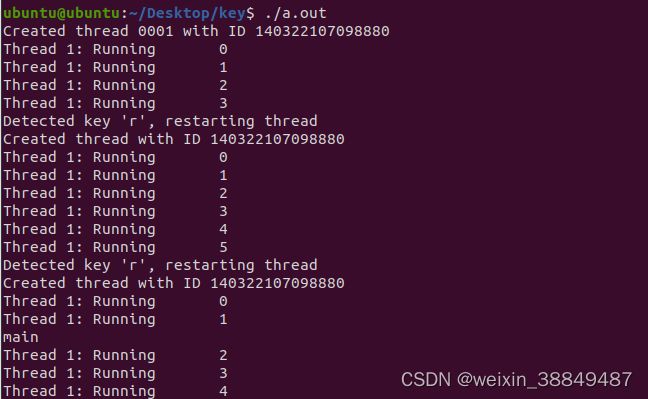linux线程重启
以下是获取线程id和重启指定线程的示例代码:
#include 这个程序启动了5个线程来执行print_thread_id函数,并打印每个线程的ID。然后它重启了第三个线程,再次打印线程ID。
程序中,
创建线程的pthread_create函数会返回一个线程ID,
在主函数中使用pthread_join函数等待线程结束。
重启线程时,可以使用pthread_cancel函数取消线程,再使用pthread_create函数重新创建线程。
当需要取消其他线程时,可以使用 pthread_cancel 函数来向指定线程发送取消请求。以下是一个简单示例,演示了如何使用 pthread_cancel 函数来取消其他线程:
#include 在这个示例中,我们创建了两个线程 thread1 和 thread2,它们执行了 print_numbers 函数来打印数字。在主线程中,我们等待了一段时间后使用 pthread_cancel 函数取消了 thread2。然后通过 pthread_join 函数等待两个线程的结束。
需要注意的是,被取消的线程仍然需要通过 pthread_join 来等待其结束,以确保它的资源能够正确释放。
在Linux中,要对特定条件下的指定线程进行重启,可以使用以下步骤:
- 创建一个标志位来表示特定条件是否满足,例如一个全局变量。
- 在特定条件下,设置标志位。这可以在任何需要的地方完成,例如在特定的事件中或者在其他线程中。
- 在线程函数中,定期检查标志位的状态。当标志位满足重启条件时,执行线程重启的操作。
- 线程重启的操作可以使用
pthread_cancel函数来取消线程,然后使用pthread_create函数重新创建线程,确保传入相同的函数和参数。
下面是一个示例代码,演示了如何在特定条件下对指定线程进行重启:
#include 在这个示例中,主线程创建了一个线程并启动后,等待5秒后设置了特定条件满足的标志位。线程函数中定期检查该标志位的状态,当标志位满足重启条件时,使用 pthread_cancel 函数取消当前线程,然后在线程函数中调用 pthread_exit 来退出线程。主线程使用 pthread_join 函数等待线程结束。
请注意,这里只是示例代码,实际场景中需要根据具体的条件和需求来定义特定条件,并设置相应的逻辑来触发线程重启。同时,要小心处理线程重启时可能出现的资源管理和同步问题。
在检测到指定线程调用 pthread_exit 后对该线程进行重启,可以使用条件变量和互斥锁来实现。下面是一个简单的示例代码,演示了如何在检测到指定线程调用 pthread_exit 后对该线程进行重启:
#include 在这个示例中,主线程创建了一个线程后进入循环,不断等待该线程结束并进行重启。当检测到指定线程调用 pthread_exit 退出后,在主线程中调用 restart_thread 函数重新创建新的线程进行重启。
restart_thread 函数负责创建新的线程,并输出重启信息。需要注意的是,在线程重启时需要进行适当的资源管理,确保新线程能够正确运行,同时需要注意避免资源泄露等问题。
这里使用了条件变量和互斥锁来实现线程重启的同步控制,确保线程的重启操作能够在适当的时机进行。
是的,在Linux C中,你可以使用一个单独的线程来检测特定的按键按下事件,并在检测到按键按下事件后对指定线程进行重启。这种方法可以通过线程间的通信来实现,例如使用条件变量和互斥锁。
下面是一个简单的示例代码,演示了如何在特定条件(检测到按键按下)下对指定线程进行重启,并将按键检测放在一个单独的线程中:
#include 在这个示例中,我们增加了一个check_key函数用于检测按键按下事件。该函数通过getchar函数获取标准输入中的按键输入,在检测到按键r按下后,调用pthread_cond_signal来触发条件变量,实现对指定线程的重启。在主线程中,我们添加了对条件变量的等待,以便在检测到按键按下后实现线程的重启。
需要注意的是,这里使用了互斥锁和条件变量来实现线程的同步控制,确保对线程的重启操作在适当的时机进行。
这种方法可以有效地将按键检测与其他操作隔离开来,提高了程序的可维护性和可扩展性。
#include 